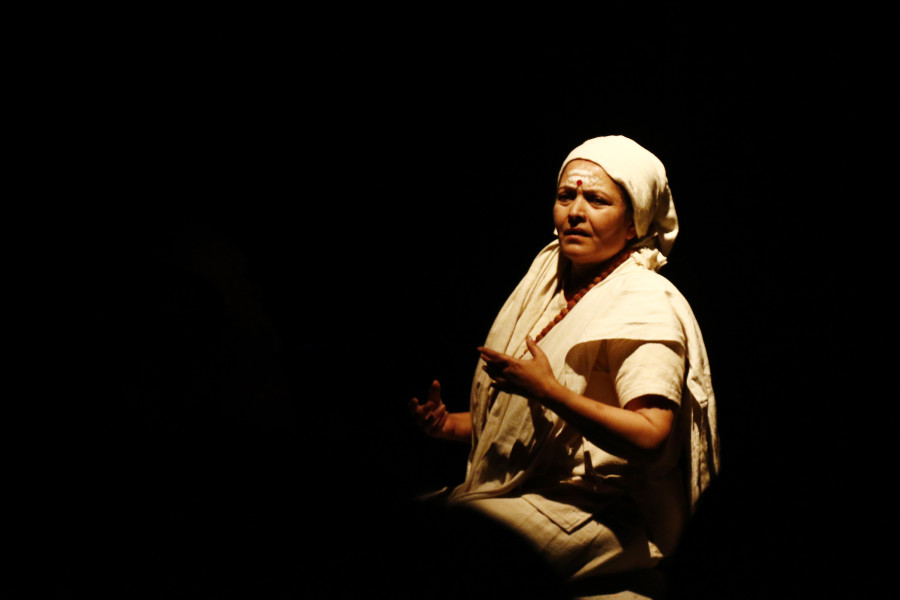Theater
Tanka Chanulagain’s Yogmaya depicts the forgotten history of resistance and revolution
Although the play might leave history enthusiasts wanting more, the experience of watching a fragment of fading history is worthwhile.
Arya Mainali
A middle-aged woman draped in white sari screams in agony as she runs towards the village. “They burnt her alive. She screamed in pain, but they watched her burn alive,” she cries. The women in the village hold their children close to them as they stretch their necks to watch: a woman burned alive in her dead husband’s funeral pyre, a Sati ritual being performed.
As the scene continues, with the piercing screams and cries of women and children filling the auditorium at Shilpee Theatre, the audience watches with an aching silence until the stage turns dark.
Director Tanka Chaulagain’s Yogmaya quickly sets the theme of social injustices, especially the state of women in Nepal during the mid-nineteenth to mid-twentieth century. Set in the village of Majhuwabesi, a village in eastern Nepal, the eponymous play is about Nepal’s first few female rights activists and the pioneer of the first Nepali women’s organisation Nari Samiti.
The storytelling sharply jumps from one scene to another, which can make it difficult for the audience to follow the direction of the play in the beginning. The first few minutes of the play can be particularly confusing too, especially for those who are unfamiliar with the history of the titular character. But as the storyline proceeds, it sets the premise for what is to come later in the play when the villagers decide to join the legendary revolution.
The play, based on Neelam Karki Niharika’s Madan Puraskar winning publication of the same name, is based on the real-life events surrounding the activism of Yogmaya Neupane, a religious leader and women rights activist from Majuwabesi village in Bhojpur district of Nepal. Yogmaya is known for fighting against cultural and political oppression during the Rana regime.
The play, to make the audience understand Yogmaya’s revolt and her contribution in challenging the dictatorial Rana regime, poignantly portrays fear and terror experienced by the people of political persecution in addition to unjust social traditions of patriarchy and caste-system.

The play brings to the fore the hidden history of Nepali feminism and activism. While writer Niharika brings the efforts of Yogmaya and her disciples in literature, director Chaulagain brings to life the long-lost voices of resistance—portraying the years-long revolution to hit the emotions of the audience.
Yogmaya is played by the veteran actor Mithila Sharma, who is known for her seamless transition from feature films and television to theatre. As Yogmaya, Sharma successfully breathes life to the character of a historic poet and revolutionist. Saraswati Adhikari, who portrays the role of Purhetni, brings humour to the otherwise serious play, with her timely one-liners. Similarly, Prabhakar Neupane as Prem Narayan Bhandari is also aptly cast as a progress-seeking pundit. His presence in the background during one scene where he keeps performing a puja while Shree tin’s guards capture and torture Yogmaya and her disciples makes the scene even more nuanced.
While the play marks an important milestone in bringing the history of Majhuwabesi to light, the stage keeps the experience from being wholesome. Throughout the play, the lighting is mostly misplaced as it does not stay focused on the characters’ faces, making it harder for the audience to read their emotions and connect with them.
The use of natural sounds throughout the play, however, is commendable. The tragic thud of the madal in the background, the sweet melody of the flute and the occasional sound of flowing water facilitates the play, taking the audience back to a different time.
Humour in the play is laced with a shade of darkness—although audiences laugh at the one-liners and casual sexism, racism and classism, they quickly empathise with the characters on the stage.
The play concludes with Yogmaya and her disciples committing mass suicide—reminiscing the real-life incident from 1941 AD. But, in the play, the characters only blow out diyos, a metaphor for their death. For audiences without previous knowledge of the event, this comes off as the characters burning themselves alive—bringing the fight against Sati system to a full circle.
Yogmaya is a commendable attempt at bringing back the history we have forgotten—a must watch for today’s Nepali society, which is still trying to fight against the similar social injustices.
The play will be staged every day except on Tuesdays at 5:25 PM, with additional shows every Saturday at 1:00 PM, at Shilpee Theatre, Battisputali, until July 1.




 8.12°C Kathmandu
8.12°C Kathmandu










